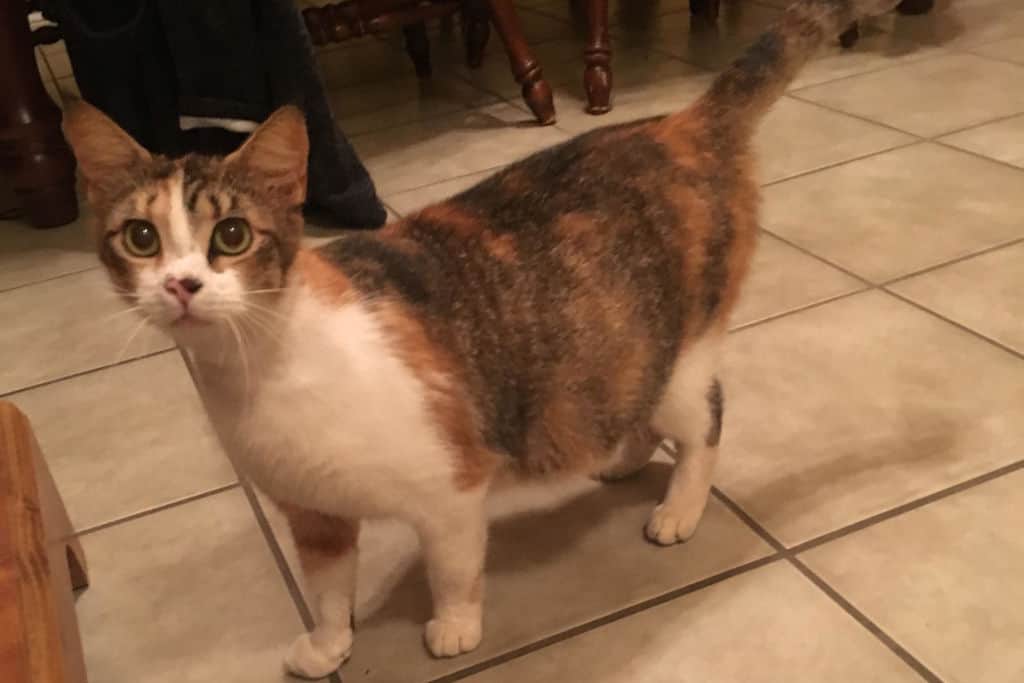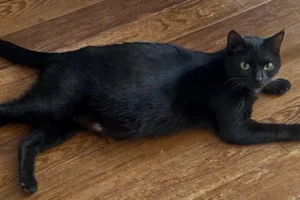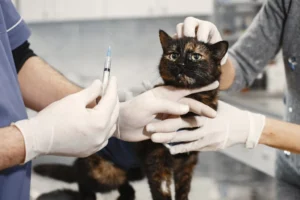Note: We may earn a commission from helpful, relevant links in our content. No cost to you. See our privacy policy.
If you’re looking to distinguish a pregnancy in a cat versus having worms, there are a few signs you can look for.
Sometimes, it can be difficult to tell one from the other. Fortunately, the vet will be able to inform you if she has worms or is pregnant, as well as treat her if she does have worms.

How Do You Tell if Your Cat Is Pregnant?
A cat’s nipples changing is the first sign of pregnancy. Her nipples will develop pinker and larger about three weeks after mating, known as “Pinking.” Your cat’s affection may grow, followed by an increase in appetite.
Cats have a gestation period of about 65 days. She will get less active and grow bigger. Later in the pregnancy, her teets will become more prominent, and her hair will fall from around them.
A practical tip to differentiate between pregnancy and worm infestation is to softly palpate your cat’s abdomen. Around the 20th day, with some care, you might feel the small sizes of developing kittens. However, always approach with caution as pressing too hard might harm them.
If she is not pregnant, she will undergo a heat cycle every 3 to 4 weeks. She’ll get more amorous and caterwaul and strive to get outside.
As the pregnancy progresses, your cat may exhibit ‘nesting’ behavior. She might start looking for a place to give birth to her kittens. She will attempt to enter closets, cupboards, and other private areas.
You should take her to the vet to be sure. They’ll inform you whether she’s pregnant and what else you need to look for during your cat’s pregnancy.
How Do You Tell if Your Cat Has Worms?
Figuring out whether a cat has worms can be difficult, but there are a few signs you should look for, such as vomiting, diarrhea, decreased weight loss, swollen abdomen, poor body condition, and dull coat. The cat may also show worms in a stool.
Internal parasites of many forms can create difficulties in cats. Roundworms, heartworms, tapeworms, and hookworms are examples.
Roundworms look like cooked spaghetti, Tapeworms resemble dried grains of rice or flat white sunflower seeds, and Hookworms look like shorter spaghetti noodles.
Roundworms are the most prevalent worms in cats. Cats with minor roundworm infections may not show any signs of disease. Those with more severe infestations may appear skinny, with poor hair coats and a pot-bellied appearance. Some people may become anemic and have nausea, diarrhea, or constipation.
Hookworms and whipworms are extremely small and nearly hard to detect in feces or vomit.
Tapeworms can be seen as pieces that move around the anus of the animal. These pieces can look like white rice or cucumber seeds moving around the anus.
It may be impossible to tell what worms she has until you take a fecal sample and have it checked. Her symptoms could be caused by factors other than pregnancy or a high worm load.
When kittens develop worms, they appear bloated, while adolescent and adult cats do not. As a result, the only way to be sure is to examine the cat’s stool.

The worms can sometimes be seen in their excrement or hanging off their buttocks. Roundworms (ascarids) are several inches long and resemble spaghetti. They can be found in the stool or vomit of an infected pet. They are usually not visible.
While visual cues can sometimes point to pregnancy or worms, a cat’s behavior also plays a crucial role. For instance, a pregnant cat may exhibit a noticeable decrease in her activity levels, while a cat infested with worms may drag its hindquarters across the floor due to itchiness.
If there is nothing in his stool and you are still concerned, I would contact your veterinarian, who may perform a fecal sample and look for larvae and eggs under a microscope.
What Can Be Mistaken for Pregnancy in Cats?
Conditions that may be confused with cat pregnancy include:
- mastitis (mammary gland inflammation),
- mammary gland neoplasia (cancer),
- organ or fluid retention-related abdominal growth,
- or pyometra (infection of the uterus)
If a cat has worms, she may vomit, but she may also vomit when she has worms, which can be mistaken for the other. In addition, both pregnant cats and cats with worms may have enlarged abdomens.
There is also the possibility of a fake pregnancy or pseudopregnancy. A hormonal imbalance is hypothesized to play a vital role in forming a false pregnancy, in which a non-pregnant female cat exhibits lactation or nursing without carrying kittens.
Unless symptoms persist, therapy is usually unnecessary. Otherwise, your veterinarian may propose hormonal supplementation or ovariohysterectomy (removal of the ovaries and uterus) to prevent further instances.
It’s a common misconception that a pregnant cat can’t get worms. However, if your pregnant cat starts losing weight rapidly or has digestive issues like diarrhea, it’s crucial to consider worm infestation alongside the pregnancy.
Can Indoor Cats Get Worms?
There’s always a chance your cat can get worms, even if it’s a 100% indoor cat. For example, she could get tapeworms from eating flies. Tapeworms require fleas or flies to complete their life cycle and are extremely difficult to eradicate.
If your cat or other cats were not on parasite preventatives for an extended time, they might have shed many flea eggs into the environment. These eggs can survive for long periods of time in indoor conditions such as flooring, rugs, and cracks. Check our guide for cat flea treatment.
Your cat may have eaten a mouse or bug that got into your home or come into contact with contaminated feces. Rodents can carry lungworms and other types of worms.
You or visitors can bring dirt-containing parasites like worm eggs on your shoes or clothing. Cats lick their feet, which may contain parasites. As a result, indoor cats can catch worms.
If your cat is not already being treated for parasites, you should consult your veterinarian about commencing treatment.
Is your veterinarian performing a fecal as part of your annual checkup? Deworm your cats at least once a year. Our house cats are dewormed once a year and have a fecal checkup.

How Can You Treat Worms in a House Cat?
The best course of action is to consult a veterinarian if you suspect your cat has worms. They can prescribe the right dewormer based on the type of worm infestation.
Over-the-counter dewormers, like pyrantel pamoate (for roundworms and hookworms) and praziquantel (for tapeworms), may be available at large pet stores, but it’s always better to seek professional advice.
Be cautious when using over-the-counter wormers from grocery or pet stores, as they may not be as effective and could be harmful to your cat.
If you suspect your cat has worms, I recommend contacting your veterinarian to see if they can prescribe a dewormer for you to give to your cat. After the first pill, do a complete litter clean out, followed by another after the second. To prevent reinfection, shovel the litter many times every day.
Bring a fresh fecal sample to the vet, preferably on the same day, and do not freeze it. It simplifies diagnosing because veterinarians identify the disease by examining eggs in the feces under a microscope.
Because they are so easily transmissible, most cats with outside access should be dewormed once a year.
For those who have multiple cats at home, if one cat shows symptoms of worms, it’s prudent to check all your feline companions. Worms can easily spread in shared litter boxes or when cats groom each other.
FAQs
How do you tell if a stray cat is pregnant or has worms?
Most wild cats have worms, and around 80% pass them to their kittens. Signs of a pregnant stray cat are similar to those of a house cat: a swollen belly and darkened pink nipples. She will start nesting and looking for a safe spot and have an increased appetite.
Because strays are outdoor cats, there’s a good chance they’re both pregnant and infected with worms. It would be best for her to find a place to stay, such as a shelter.
Can you use a human pregnancy test on a cat?
No, a human pregnancy test won’t work on cats because of the difference in hormones. This test tests the Human Growth Hormones, which are only produced by a woman when she’s carrying a baby.
How long does it take to notice a cat is pregnant?
Examining the cat’s nipples is one way to determine whether she is pregnant. About three weeks into her pregnancy, she will experience swollen nipples. In addition, your veterinarian can use an ultrasound to confirm pregnancy after about 22 days.
Alex, a passionate animal lover, has experience in training and understanding animal behavior. As a proud pet parent to two dogs and three cats, he founded AnimalReport.net to share insights from animal experts and expand his knowledge of the animal kingdom.









